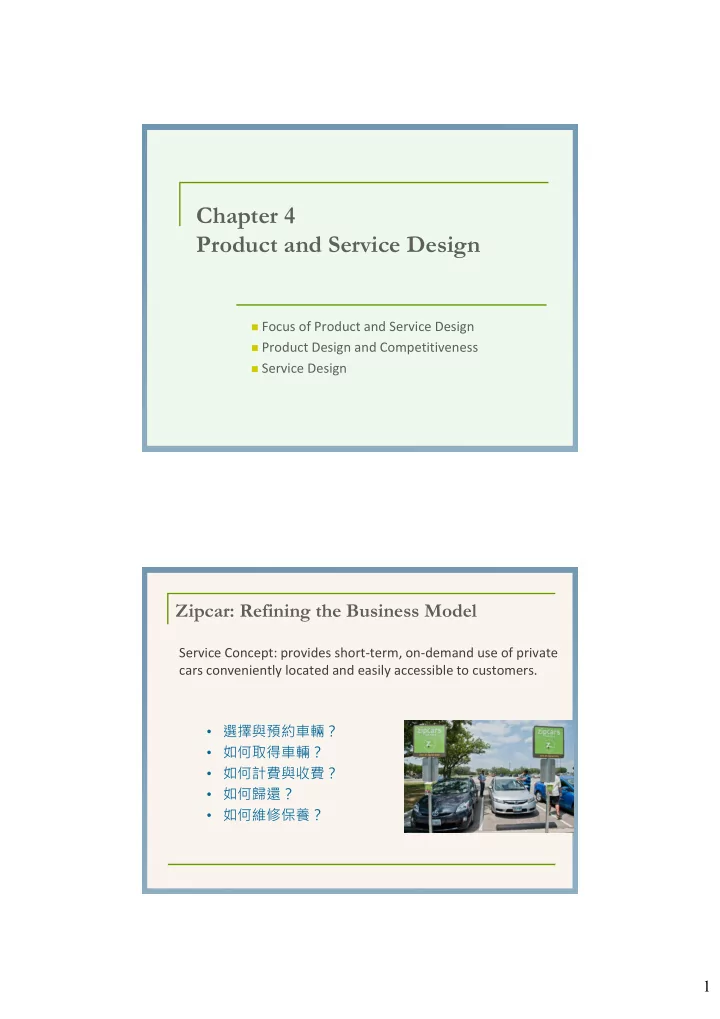

Chapter 4 Product and Service Design Focus of Product and Service Design Product Design and Competitiveness Service Design Zipcar: Refining the Business Model Service Concept: provides short‐term, on‐demand use of private cars conveniently located and easily accessible to customers. • 選擇與預約車輛? • 如何取得車輛? • 如何計費與收費? • 如何歸還? • 如何維修保養? 1
What Does Product or Service Design Do? Product and service design—or redesign—should be closely tied to an organization’s strategy 產品代表競爭力 1. Translate customer wants and needs into requirements 規格化 Refine existing products Develop new products and services 改善現有 and services 全新設計 Formulate quality goals 品質 Formulate cost targets 成本 6. Construct and test prototypes 試驗 7. Document specifications 食譜:能做出相同的料理 8. Translate into process specifications. 3 Idea Generation 點子哪裡來? Research and Development R&D Basic Research Applied Research Development 服務業缺乏專利保護 Reverse Engineering 逆向工程 Dismantling and inspecting a competitor’s product to learn and to discover possible improvements. Original Design Manufacturer ODM 設計代工 4 2
Product Standardization 單一標準規格? Advantages: Fewer parts to deal with in inventory and manufacturing 庫存與排程 Quality is more consistent Opportunities for long production runs and automation 自動化 Disadvantages Decreased variety results in less consumer appeal 5 Value Analysis/Value Engineering Examination of the function of parts and materials to reduce costs of order qualifiers and order winners Is the item necessary? 游泳池 Could another material be used instead? Can specifications be less stringent? Can two or more parts be combined? Can packaging be improved to save cost? 採購運用VA以降低採購成本 研發運用VE以避免增加製造成本 6 3
Design For Assembly : A form of standardization in which component parts are grouped into modules that are easily replaced or interchanged. 半自助旅遊 Delayed differentiation The process of producing, but not quite completing, a product or service until customer preferences are known. 7 The Kano Model 狩野紀昭 order winner order qualifier 8 4
Design for Production 將好的設計製造出來 Concurrent Engineering 同步工程 First to market bringing engineering design and manufacturing personnel together early in the design phase. Quality Function Deployment 品質機能展開 integrate the voice of the customers into product development. 9 10 5
Design for Logistics 11 Legal and Environmental Factors Product liability 產品責任 : the responsibility of a manufacturer for any injuries or damages caused by a faulty product. The Three Rs Reduce: reduce waste, reduce cost Reuse: refurbishing used products Recycle: recovering materials for future use. 12 6
Design Service is Different Tangible and intangible 無形性 Customer Involvement – created and delivered at the same time 同時性 Services cannot be inventoried 易滅性 Services highly visible to customers (front office) 前後場 Services have low barrier to entry (competition) Location is important to service design Range of service systems 異質性 Demand variability 13 Designing Service Package Supporting facility: physical resources that must be in place before a service can be sold 建築外觀、內部裝潢 Facilitating goods: material consumed by the service process 餐盤、食材、商品 Information: operations data or information to enable efficient and customized service 庫存紀錄、教材 Explicit services: benefits readily observable 停車場、網頁 Implicit services: psychological benefits which the consumer may sense only vaguely 服務效率與態度 14 7
location, interior design Customer Supporting Facility Participation service blueprint, Facilitating Goods service recovery Simultaneity Information revenue Perishability management Explicit Services Intangibility Implicit Services service encounter Heterogeneity capacity planning, waiting line management Supporting Facility: Shouldice Hospital 16 8
Zipcar’s Service Package Supporting Facility : office, parking space. Facilitating Goods : membership card, cars, recorder, gasoline. Information : web site, reservation system, driving records. Explicit Services : cleanliness. Implicit Services : 24 7 availability. Designing Service Process Degree of Complexity : Measured by the number of steps in the service process, e.g., a clinic is less complex than a general hospital 流程長度 Degree of Divergence : Amount of discretion permitted the server to customize the service, e.g., the activities of an attorney contrasted with those of a legal assistant 流程多元性 18 9
Degree of Complexity/Divergence No Take Table Reservation Reservation Selection Seat guests Self-seating Seat guests Recite menu Fills out Take orders Take orders order Personal service Serve Separate-course Call number service dinner sets 19 Controlling Complexity One‐stop service results in lower complexity. Focused strategy must be unique or of very high quality. 專注策略與高品質 Adding more services to increase revenue from each customer creates high complexity. Superstores with banking, flower shops, and food service complicate the management process. 多元化與管理困難度 20 10
Swim Lane Flowchart (for low contact service) 21 A Service Blueprint for a Restaurant 高接觸 顧客到達 顧客離開 用餐 Interactive F Line 前場 訂位 入座點菜 上菜 結帳 Line of Visibility F F 通知廚房 烹飪 準備帳單 後場 Line of Support 準備材料 Fail‐safing = pokayokes service encounter moments of truth 22 11
Customer Contact: Information Technology • Mobile technology and web sites enable vehicle reservation and usage. 行動通訊 • RFID tag and wireless transmission authorizes users, car equipment reads odometer, mileages, and time stamps. 無線 射頻與通訊 12
Support: Maintenance and Relocating Increasing Customer Value 𝑊𝑏𝑚𝑣𝑓 � Qualit𝑧 Cost Process quality � Results produced 𝑊𝑏𝑚𝑣𝑓 � Cost of acquiring the service � Price to the customer 26 13
Business Collaboration 27 標準化服務? Standardizing or reducing consumer choices makes service more efficient, but it can be both frustrating and irritating for the customer. 自動化或自助服務? Automation or reducing customer contact can reduce the cost of providing a service, but it risks eliminating features that some customers value, such as personal attention. 兼職人員? Hiring part‐time or temporary staff reduces cost and increases capacity flexibility, but the use of less‐skilled or less‐interested people may hurt service quality. 28 14
Customer as Co‐Producer having customers taking a greater role enhances the service Self service cost, speed, convenience, customization 24 7 service availability Appointments and reservations Customers generated content Wiki, e‐markets 29 Conclusion 產品的設計直接決定 企業競爭力 產品設計要面對顧客需求、 市場競爭、技術演進 成功的產品設計考慮到對製造與儲運 的影響,以及對環境的影響 無形內容與顧客在場影響服務業的產品設計 服務業的員工招募與訓練須符合產品設計 30 15
Recommend
More recommend